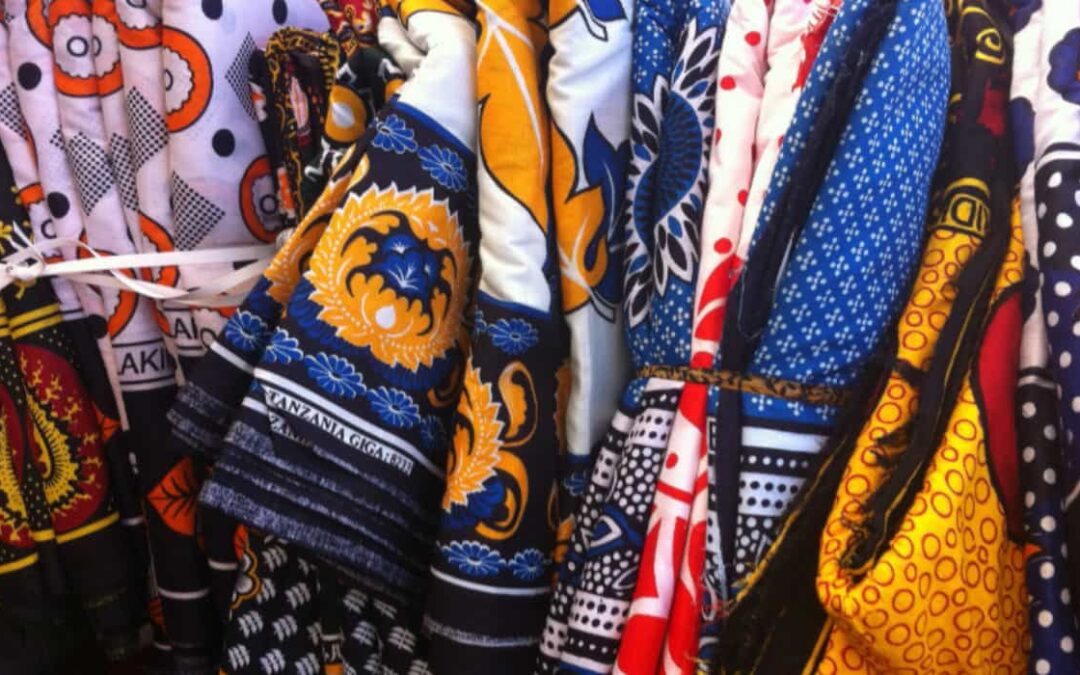“Nearly 1.65 metre long piece of cloth with square borders is known as Kanga in East and West Africa and locals mostly use this to cover their heads,” Kitenge is a 12-metre long cloth used by the Africans mainly to wrap up the waist.
Kangas play an important role in modern Swahili culture. Read on to learn more about kangas including their origins, how they are used and worn today and their unique meanings.
KANGA: A TYPE OF AFRICAN PRINT CLOTHING
Kanga (also called ‘Leso’ in Kenya) is a rectangular shaped, 100% cotton, printed cloth with a brightly coloured decorative boarder around the outside and includes a Swahili proverb.

A kanga ‘Commemorating the life and mourning the death of Julius Nyerere, 1922-1999, the father of Independent Tanzania’ (The British Museum, London)
Kanga is usually bought in a pair (2 pieces joined together) and need to be cut and sewn along the raw edge to separate them before being worn. Kanga is extremely popular in East Africa and is worn daily by millions of women.
The kanga, is a colourful fabric similar to kitenge, but lighter, worn by women and occasionally by men throughout the African Great Lakes region. It is a piece of printed cotton fabric, about 1.5 m by 1 m, often with a border along all four sides (called pindo in Swahili), and a central part (mji) which differs in design from the borders. They are sold in pairs, which can then be cut and hemmed to be used as a set.
The kanga is culturally significant on Eastern coast of Africa, often given as a gift for birthdays or other special occasions like weddings. They are also given to mourning families in Tanzania after the loss of a family member as part of a michengo (or collection) into which many community members put a bit of money to support the family in their grief. Kangas are also similar to Kishutu and Kikoy which are traditionally worn by men.
If you are a guest at somebody’s house then they may present you with your own kanga, which is a sign of friendship. They say that every woman should own a thousand kangas!

Tanzanian kanga designs displayed at The British Museum
Kanga is a much lighter and thinner cloth than Kitenge (also known as African wax print or ‘ankara‘ in West Africa). Kitenge is usually bought in continuous 3 or 6 pieces and is more popular for making clothing, curtains, cushions and bedding.
HISTORY OF KANGA
Kangas have existed in East Africa since the mid 19th century. In the 1870s Muslim Women in Zanzibar and Mombasa, Kenya, bought printed bandanas, imported by Portuguese traders. They sewed 6 of these colourful bandanas together to make a unique piece of cloth, which they could wear modestly.
Traders along the Swahili coast quickly reacted to this emerging trend and arranged for designs to be hand-stamped, using carved wooden blocks, onto a single piece of locally woven cloth instead of lots of smaller squares sewn together.

Women in Zanzibar wearing kangas whilst bartering for fish at the market
The cloth is named after the Swahili word for the spotted black and white guinea fowl. This is due to the fact that the first printed cloths used a similar print to that found on the guinea fowl, which was very popular at the time.
MODERN KANGA PRODUCTION
Today, there are a large number of different Kanga designs available to import from india. Kangas were commonly produced in India. They now use large, industrial rotary screen-printing machines and can produce large quantities in bulk.
The design is first created by hand using a fine paintbrush. It is then transferred onto a computer and the different layers of the design are printed onto see-through, plastic screens. These screens are then transferred onto the rollers for printing. Each roller will print a different colour of the design directly onto the cloth.

A rotary screen-printing machine

Large scale Kanga production at an integrated textile mill

A kanga shop in Tanzania, East Africa
Kanga Uses
Kangas are incredibly versatile and are often worn as traditional African clothing but also to sleep in, wear around the house when cooking and cleaning and for carrying babies in. They can also be used as curtains, mops, towels, aprons, tablecloths and are really handy to take to the beach.
The cloth is also worn by guests, or the bride, at Swahili weddings (people from the coast). The traditional ‘wedding’ kanga (called ‘kisutu’ in Swahili) is white, black and red in colour.

A traditional wedding kanga called a ‘kisutu’ in Swahili displayed at The British Museum
Kangas are very popular in Tanzania and Kenya. However, similar types of printed cloth can also be found in nearby countries including Mozambique and Madagascar where men usually wear them instead.
Kanga Sayings
Swahili proverbs were added to kanga designs at the beginning of this century. Some examples include:
- Usinisumbue (don’t bother me)
- Adui mpende (love your enemy)
- Akili ni mali (wits are wealth)
- Mtaka yote hukosa yote (one who wants all, usually loses all)
- Kulekeza si kufuma (to aim is not to hit)
- Sina siri nina jibu (I have no secrets but I have an answer)
Women will wear a specific kanga to communicate a non-verbal message to their community. This form of communication, often between women, can be about personal feelings, relationships, politics, education, health or religion.
How to wear Kanga
There are numerous ways of wearing a kanga. They can be worn as a top, skirt, shawl, cape, belt, headpiece or even a swimsuit. The most common style is the traditional dress, which is worn like a towel or a skirt, wrapped around your hips. It is common to wear more than one kanga at a time.
Popular A-line shaped, African print skirts feature a black, elasticated waistband and inside lining. The below images show how you can wear our kanga flare skirts.

Photoshoot of our Red African Print Flare Skirt (Credit: Sai Studio Photography)

(Credit: Sai Studio Photography)

(Credit: Sai Studio Photography)
We hope you have enjoyed learning about kanga cloth. Visit our African print fabrics to browse our current collection of kanga fabrics! You can also click on the links below to learn more about traditional African textiles and how they are made.

